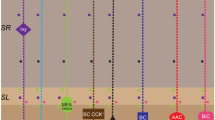The influences of hippocampal fields CA1 and CA3 on the spike activity of respiratory neurons in the bulbar respiratory center were studied in normal conditions and hypoxia. In normoxia, stimulation of hippocampal fields CA1 and CA3 had mainly inhibitory influences. During oxygen insufficiency, the activity responses of respiratory neurons in the bulbar respiratory center to stimulation of these structures were phasic. At the beginning of the “elevation” to an “altitude” of 4000–5000 m, the small decrease in pO2 in inspired air induced an increase in neuron spike activity. On this background, the inhibitory influence of stimulation of hippocampal fields CA1 and CA3 was more marked than in normoxia. At an “altitude” of 7500–8000 m, with severe oxygen deficit, the inhibitory influences of hippocampal fields CA1 and CA3 were minor on the background of sharp suppression of baseline neuron activity in the respiratory center. Comparative analysis of the activities of inspiratory (IN) and expiratory (EN) neurons at different stages of hypoxia revealed marked differences in their behavior, in that IN had relatively greater resistance to hypoxia than EN. Among subgroups of IN, early and complete IN were more resistant to oxygen deficit. After the “descent” of the animals to normal atmospheric pressure, there was gradual recovery of the initial values of both spontaneous phasic neuron activity and responses to stimuli.
Similar content being viewed by others
References
E. A. Airikyan and O. D. Gaske, “The involvement of the hippocampus in the body’s autonomic functions,” in: The Central and Peripheral Mechanisms of the Autonomic Nervous System [in Russian], Academy of Sciences of the Armenian SSR Press, Erevan (1975).
N. S. Akopyan, N. Yu. Adamyan, N. V. Sarkisyan, R. S. Arutyunyan, and M. A. Karapetyan, “The influences of limbic structures on respiration in conditions of hypoxia,” Usp. Fiziol. Nauk., 35, No. 4, 41–48 (2004).
A. A. Boldyreva, “Lanthanum potentiation of GABA-activated currents in pyramidal neurons in hippocampal field CA1 in rats,” Byull. Eksperim. Biol. Med., 140, No. 10, 398–401 (2005).
A. V. Valdman, A. A. Grantyn, and G. A. Denisov, “Neuropharmacology and physiology of the central regulation of respiration,” in: Neuropharmacology of Processes of Central Regulation [in Russian], Typogr. No. 12, Leningrad (1969), pp. 405–476.
O. A. Vedyasova, “The respiratory effects of stimulation of the limbic cortex and their modulation by serotonin in rats,” Byull. Eksperim. Biol. Med., 140, No. 9, 244–246 (2005).
V. E. Okhotin, I. V. Dyuizen, S. G. Kalinichenko, and G. Yu. Sulimov, “The GABAergic basket-pyramidal and basket-granular system of the hippocampal formation in cats,” Byull. Eksperim. Biol. Med., 120, No. 6, 644–646 (1995).
V. A. Safonov, V. N. Efimov, and A. A. Chumachenko, The Neurophysiology of Respiration [in Russian], Meditsina, Moscow (1980).
V. A. Safonova, Humans in an Ocean of Air [in Russian], Nauka, Moscow (2006).
S. S. Tkachuk, A. V. Tkachuk, V. F. Myslitskii, and A. M. Lenkov, “Pathogenetic basis of age-related differences in the selective sensitivity of the hippocampal fields in rats to ischemic injury,” in: Proceedings of the II CIS Congress of Physiologists “Human Physiology and Health” [in Russian], Meditsina-Zdorov’e, Moscow, Kishinev (2008).
P. E. Bickler and B. M. Hansen, “Hypoxia-tolerant neonatal CA1 neurons: Relationship of survival to evoked glutamate release and glutamate receptor-mediated calcium changes in hippocampal slices,” Dev. Brain Res., 106, No. 1–2, 57–69 (1998).
M. Fujioka, K. Nishio, S. Mikjamoto, K. Hizamatsu, T. Sakaki, K. Okuchi, and T. Taoka, “Hippocampal damage in the human brain after cardiac arrest,” Cerebrovasc. Dis., 10, No. 1, 2–7 (2000).
A. A. Galoyan, J. S. Sarkisyan, T. K. Kipriyan, Y. K. Grigorian, A. S. Andreasian, and E. A. Chavushyan, “Comparison of the protection against neuronal injury by hypothalamic peptides and by dexamethasone,” Neurochem. Res., 25, No. 12, 1567–1578 (2000).
R. Nieuwenhuys, V. Jan, and H. C. Van, “Greater limbic system,” in: The Human Central Nervous System, 4th edition, Academic Press, New York (2008), pp. 213–269.
G. Paxinos and C. Watson, The Rat Brain in Stereotaxic Coordinates, 2nd edition, Harcourt Brace Jovanovich Publishers, San Diego, New York, London, Tokyo (1986).
Author information
Authors and Affiliations
Corresponding author
Additional information
N. S. Akopyan (Deceased).
Translated from Rossiiskii Fiziologicheskii Zhurnal imeni I. M. Sechenova, Vol. 97, No. 2, pp. 169–179, February, 2011.
Rights and permissions
About this article
Cite this article
Arutyunyan, R.S., Adamyan, N.Y., Karapetyan, M.A. et al. Regulatory Influences of Hippocampal Fields CA1 and CA3 on Bulbar Respiratory Neurons in Conditions of Hypoxia. Neurosci Behav Physi 42, 620–627 (2012). https://doi.org/10.1007/s11055-012-9612-0
Received:
Published:
Issue Date:
DOI: https://doi.org/10.1007/s11055-012-9612-0




